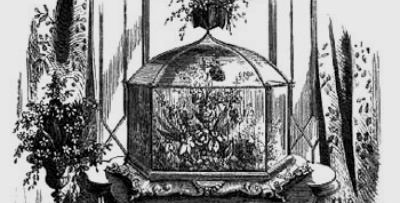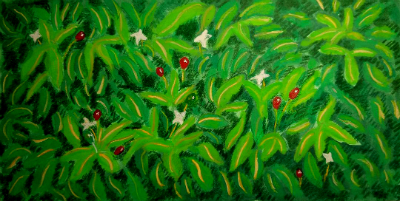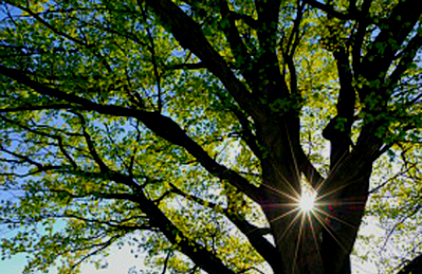
bringing nature, nurseries and gardeners together Nov. 27, 2020
|
|
NeighborWoods Free Trees: Apply to TreeFolks to receive a free tree in February and March. Gardeners can choose contact-less drive through, or home delivery. TreeFolks ❦
____________________________ _____________________
Natural Gardener News: an astonishing 25% off entire store and nursery (excluding gift cards), now through Dec 24. Covid restrictions in place; check website before heading south. Natural Gardener ❦
 _________________________________________________
Caterpillar battles: some shocking news from the normally placid world of lepidopterists."Before metamorphosis, monarch butterflies will aggressively head butt each other for access to (milkweed), their favorite food," reports Katherine J. Wu. In some cases, they will go as far as cannibalism. New York Times ❦

Wardian Cases: these historic mini greenhouses were invented by Victorians in the mid-1800s to transport rare plant specimens. Now they are coming back into vogue as plant display cases inside homes. Gardenista ❦
_________________________________________________
Bee Food Plant List: another raid on the resources page of the amazing Barton Springs Nursery led to the discovery of this guide, compiled by Eva Van Dyke. She breaks the list down into trees and shrubby trees, perennials, and perennial grasses. Barton Springs Eternal ❦
Help Turn Hancock Golf Course into a greenspace: after 122 years of golf, it's time to open the gates for all to enjoy this beautiful crown jewel of a park in central Austin. Hancock Conservancy Poll. ❦
 Lovers of peppers everywhere, meet the ancestor of nearly all of them: the humble Chile Pequín, native to Tabasco, Mexico, and growing wild in neighboring regions such as Texas (writes Andy Balinsky). Thanks to generations of indigenous knowledge and cultivation, there are sweet, spicy, big, and small varieties of Capsicum annuum. So, if you love any kind of cuisine that involves spicy or sweet peppers, thank the indigenous peoples of this continent. (Illustration by Linda Anderson
_________________________________________________
Central Texas Gardener: "Drought to Deluge: the Resil-ient Central Texas Garden" is a fine new book from Travis County Master Gardeners. In their zoom video, Linda Lehmusvita interviews author Sheryl Williams. CTG-YouTube Buy the book ($27.95) here: TCMGA ❦
 Our Awesome Tree Canopy
by Chris Winslow
First time visitors to the Austin and Hays County area are often astonished by the number of trees that we have in our gardens and parks. National Geographic magazine noticed recently, and ranked Austin as a city with the second highest urban tree canopy in the nation, with 37% coverage.
Maybe we take them for granted, but the presence of these glorious oaks, elms, mesquites and pecans creates a beauty, and a quality of life that we should be thankful for every day.
With cooler temperatures starting finally to arrive, this month is the perfect time for us to introduce more trees into our landscapes. Below is a list of some of my favorites. Once established, these trees are drought tolerant and thrive in our central Texas landscapes.
Southern Live Oak (Quercus virginiana) – One of the leading native trees of our area. It can grow to 30 to 40 feet in height by 50 feet in width. Its’ evergreen canopy provides generous shade as well as a windbreak from the winter cold when planted on the north side of the house.
Mexican White Oak or Monterrey Oak (Quercus polymorpha) – Another evergreen oak from northern Mexico that’s gaining in popularity because of its large leaves and great pyramidal shape. It has the added benefit of being resistant to oak wilt disease which has taken many a tree in our south Austin and northern Hays County neighborhoods.
Red Oak or Spanish Oak (Quercus shumardi and Quercus texana) – The Shumard red oak reaches a height of 50 feet in time, and can make a magnificent specimen. They are deciduous, and turn a brilliant red in the fall.
If you plant one on the south or west side of the house, it will provide shade in the summer months, and in the fall and winter months it allows the warming sunshine to heat your house.
Quercus texana is a smaller version of this oak. It grows to a height of 20 feet and is a good choice for a small area. It also has a showy display of red leaves in the fall.
Bur Oak (Quercus macrophylla) – A stately, deciduous shade tree that’s named after the large acorns it produces. (It is also called mossy cup oak.) It can grow to a height of 50 feet and is very drought tolerant. They form a taproot, which makes them a little slower in the beginning, but they always catch up after a few years. To flourish, this oak needs lots of space.
Chinquapin Oak (Quercus mulenbergia) – My favorite oak because of its large and shapely leaves. It is a moderate grower that can reach a height of over 35 feet. Chinquapins have a beautiful white bark and turn a reddish bronze in the fall.
Cedar Elm (Ulmus crassifolia) – An under-used native tree that’s tolerant of rocky soils and thick clay. They grow 25 to 50 feet and about half as wide. Their small leaves turn a gold color in the fall.
Honey mesquite (Prosopis glandulosa) – This ever-present, although hard to find native, is a very drought tolerant tree. It has beautiful yellow flowers in the spring with light green foliage and a weeping character. The bean pods provide forage for wildlife and flowers are a great nectar source for butterflies.
Remember, for these newly planted trees, they need to be watered on a regular basis - especially because the rains have been so scarce these past months.
I let water trickle at the base for half an hour to an hour once a week when we have rains, and for two hours when we don’t. The establishment period is getting them through their first summer. The more consistent and regular the watering, the faster they will grow.
Let's all plant a tree, and take Austin's tree canopy up to the 40% mark! ❦
|
 It's About Thyme Legacy Publications.
Contact newsletter editor Darrel Mayers with any ideas for articles or interesting links at internationalrain@yahoo.com (hitting 'reply' to this email won't work) |
|
|
